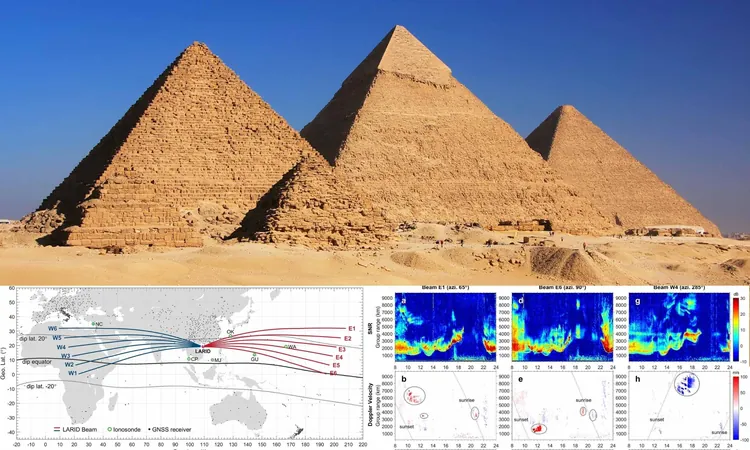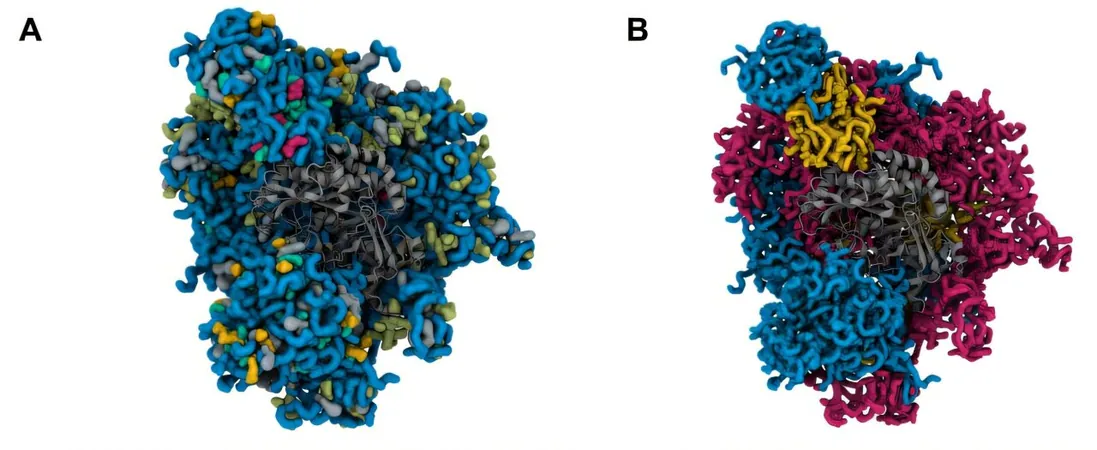
Unveiling the Mysteries: China's Radar Discovers 'Plasma Bubbles' Above Egypt's Pyramids!
2025-07-10
Author: Li
In an astonishing feat of technology, a remote radar station on China's Hainan Island has detected strange ionospheric disturbances looming over the iconic Pyramids of Giza—nearly 5,000 miles away! This remarkable achievement opens new doors in our understanding of plasma bubbles and could pave the way for safeguarding our satellites and communication networks.
The Science Behind the Sighting
Led by researcher Lianhuan Hu from the Institute of Geology and Geophysics at the Chinese Academy of Sciences, the team developed the Low Latitude Long Range Ionospheric Radar (LARID). This cutting-edge phased-array radar system fires high-frequency pulses that bounce off the ionosphere, effectively mapping out pockets of rarefied plasma that extend well beyond the horizon.
During a geomagnetic storm in November 2024, LARID successfully recorded a plasma bubble over Egypt while pointing its antennas westward. This breakthrough confirms the radar's maximum detection range of nearly 6,000 miles—over three times the capability reported during its initial tests.
Why Plasma Bubbles Matter
So, what exactly are plasma bubbles? These massive caverns of electron depletion form after sunset along Earth’s magnetic field lines, sometimes reaching up to hundreds of miles in diameter. Within these bubbles, radio signals become disrupted, wreaking havoc on GPS navigation, satellite communications, and even air traffic.
Understanding plasma bubbles has become increasingly vital. As explained by NASA, "the walls of these equatorial plasma bubbles are where communication and navigation signals are corrupted," making real-time monitoring essential, especially in tropical regions lacking ground-based sensors.
How LARID Achieves Its Incredible Scope
Operating on a frequency of 20 MHz, LARID’s design leverages the ionosphere's properties, which refracts signals back to Earth rather than allowing them to escape into space. Each signal bounce, known as a 'hop,' expands the radar's detection area, enabling it to pick up echoes from distant regions, including Africa and the Central Pacific.
Tracking the Plasma Bubbles
Unlike traditional observation methods, LARID doesn't see plasma bubbles directly. Instead, it identifies irregular echoes caused by signals scattering off unstable plasma structures at the bubble's edges. By analyzing Doppler shifts and other factors, researchers can differentiate significant disturbances from background noise.
The Connection to Space Weather
Interestingly, the Egyptian plasma bubble coincided with a major geomagnetic event—a Kp 7 storm caused by the interplanetary magnetic field shifting southward. This phenomenon generated strong electric fields, triggering conditions conducive to plasma bubble formation, further corroborated by ground GPS data from Africa.
Towards a Global Surveillance Network
Hu and his team envision a future with radar stations positioned around the globe to enhance monitoring capabilities across equatorial regions. Proposals include deploying additional systems in Brazil, Indonesia, and West Africa to cover vast oceanic areas, enabling timely adjustments to avoid communication failures.
Not only could this technology benefit civilian operations, but it also holds strategic importance for military applications. Accurate data on plasma bubbles could protect critical communication systems, thus maintaining operational integrity.
What Lies Ahead?
Looking forward, LARID's team is experimenting with multi-frequency observations to better determine the altitude of these plasma bubbles—a crucial factor for refining predictive models. With plans to launch a portable radar unit in the Indian Ocean, the potential for a global monitoring network is on the horizon.
The implications of this discovery extend deep into both scientific research and everyday technology, as researchers continue to bridge the gap between ionospheric phenomena and practical applications in meteorology and beyond.






 Brasil (PT)
Brasil (PT)
 Canada (EN)
Canada (EN)
 Chile (ES)
Chile (ES)
 Česko (CS)
Česko (CS)
 대한민국 (KO)
대한민국 (KO)
 España (ES)
España (ES)
 France (FR)
France (FR)
 Hong Kong (EN)
Hong Kong (EN)
 Italia (IT)
Italia (IT)
 日本 (JA)
日本 (JA)
 Magyarország (HU)
Magyarország (HU)
 Norge (NO)
Norge (NO)
 Polska (PL)
Polska (PL)
 Schweiz (DE)
Schweiz (DE)
 Singapore (EN)
Singapore (EN)
 Sverige (SV)
Sverige (SV)
 Suomi (FI)
Suomi (FI)
 Türkiye (TR)
Türkiye (TR)
 الإمارات العربية المتحدة (AR)
الإمارات العربية المتحدة (AR)